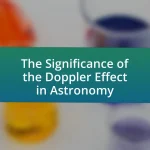Nebulae are vast clouds of gas and dust in space, primarily composed of hydrogen and helium, that serve as the primary sites for star formation. Approximately 90% of stars are born within these nebulae, particularly in regions known as molecular clouds or stellar nurseries, where gravitational collapse leads to the formation of protostars. The article explores the various types of nebulae involved in star formation, the physical conditions that facilitate this process, and the impact of external factors such as nearby supernovae. Additionally, it discusses observational techniques used to study nebulae and the implications of this research for understanding the universe’s structure and the lifecycle of stars.

What are Nebulae and Their Importance in Star Formation?
Nebulae are vast clouds of gas and dust in space, primarily composed of hydrogen, helium, and other ionized gases. They play a crucial role in star formation as they serve as the primary sites where new stars are born. The gravitational collapse of regions within these nebulae leads to the formation of protostars, which eventually evolve into fully-fledged stars. Observations show that approximately 90% of stars form within nebulae, highlighting their significance in the lifecycle of stellar development.
How do Nebulae contribute to the process of Star Formation?
Nebulae contribute to the process of star formation by providing the necessary gas and dust that collapse under gravity to form new stars. These interstellar clouds, primarily composed of hydrogen, helium, and other trace elements, create regions of high density where gravitational forces can initiate the collapse of material. As the gas and dust accumulate, they form protostars, which eventually evolve into fully-fledged stars. Observations show that star formation occurs in regions of nebulae known as stellar nurseries, where the density and temperature conditions are conducive to the gravitational collapse required for star formation.
What types of Nebulae are involved in Star Formation?
The types of nebulae involved in star formation are primarily molecular clouds, also known as stellar nurseries. Molecular clouds are dense regions of gas and dust where the conditions are suitable for the gravitational collapse necessary to form stars. These clouds contain a high concentration of molecules, particularly hydrogen, which facilitates the cooling and condensation processes essential for star formation. Observations show that regions within these molecular clouds often exhibit signs of new star development, such as protostars and accretion disks, confirming their critical role in the birth of stars.
How do the physical conditions in Nebulae facilitate Star Formation?
The physical conditions in nebulae facilitate star formation by providing dense regions of gas and dust where gravitational forces can initiate the collapse of material. These regions, known as molecular clouds, have high densities and low temperatures, which are essential for the cooling of gas and the formation of clumps that can eventually lead to star formation. The presence of various elements, such as hydrogen and helium, along with dust particles, aids in the process by allowing for the absorption of radiation and the formation of molecules. Observations show that star formation occurs in these dense cores, where the gravitational pull overcomes internal pressure, leading to the birth of new stars.
Why are Nebulae considered the birthplaces of stars?
Nebulae are considered the birthplaces of stars because they are vast clouds of gas and dust that provide the necessary materials for star formation. Within these nebulae, regions of higher density can collapse under their own gravity, leading to the formation of protostars. This process is supported by observations that show many stars are born in clusters within nebulae, such as the Orion Nebula, where ongoing star formation has been documented. The presence of hydrogen, helium, and other elements in nebulae is crucial, as these elements are the building blocks for new stars.
What role do gravity and density play in Nebulae during Star Formation?
Gravity and density are crucial in nebulae during star formation as they initiate the collapse of gas and dust into denser regions, leading to star birth. High-density areas within a nebula experience stronger gravitational forces, causing them to contract and increase in temperature, eventually forming protostars. This process is supported by the observation that regions of higher density, such as molecular clouds, are where star formation is most active, as evidenced by the presence of young stellar objects detected in these areas.
How do chemical compositions in Nebulae influence the types of stars formed?
Chemical compositions in nebulae significantly influence the types of stars formed by determining the availability of essential elements and the physical conditions necessary for star formation. Nebulae rich in hydrogen and helium, the primary constituents of stars, tend to produce more massive stars, while those with higher concentrations of heavier elements, known as metals, can lead to the formation of smaller, cooler stars. For instance, the presence of elements like carbon, oxygen, and nitrogen can enhance the cooling processes within the nebula, allowing for the formation of stars with varying masses and lifespans. Observations show that regions with higher metallicity often yield stars with different characteristics compared to those in primordial nebulae, which are primarily composed of hydrogen and helium. This relationship between chemical composition and star formation is supported by studies of stellar populations in different galactic environments, highlighting how nebulae’s elemental makeup directly impacts the resultant stellar types.

What are the Different Stages of Star Formation in Nebulae?
The different stages of star formation in nebulae include the molecular cloud stage, the protostar stage, the main sequence star stage, and the potential later stages of stellar evolution. Initially, a molecular cloud, composed of gas and dust, collapses under its own gravity, leading to the formation of dense regions known as protostars. As these protostars accumulate mass, they heat up and eventually ignite nuclear fusion, transitioning into main sequence stars. This process is supported by observations of star-forming regions, such as the Orion Nebula, where these stages can be identified through infrared and radio emissions, confirming the sequence of star formation.
What are the initial conditions required for Star Formation in Nebulae?
The initial conditions required for star formation in nebulae include high density regions, low temperatures, and the presence of molecular hydrogen. High density regions facilitate gravitational collapse, while low temperatures allow gas to condense without excessive thermal pressure. Molecular hydrogen serves as the primary fuel for star formation, providing the necessary material for protostar development. These conditions are often found in giant molecular clouds, where the density can reach thousands of particles per cubic centimeter, enabling the formation of stars through gravitational instabilities.
How does the collapse of a molecular cloud lead to star formation?
The collapse of a molecular cloud leads to star formation by increasing density and temperature, which initiates nuclear fusion. When a molecular cloud, composed primarily of gas and dust, experiences gravitational instability, it begins to collapse under its own gravity. As the cloud contracts, the material within it becomes denser and heats up due to the conversion of gravitational potential energy into thermal energy. This process can lead to the formation of dense cores within the cloud, where conditions become favorable for nuclear fusion to occur. Observations show that regions of high density within molecular clouds, known as protostellar cores, are often the sites where new stars are born, confirming that the collapse of these clouds is a critical step in the star formation process.
What are the key phases in the lifecycle of a star forming in a Nebula?
The key phases in the lifecycle of a star forming in a Nebula include the initial collapse of the molecular cloud, the formation of a protostar, the ignition of nuclear fusion, and the stabilization of the star on the main sequence. Initially, a nebula, composed of gas and dust, undergoes gravitational collapse, leading to increased density and temperature. This process forms a protostar, which continues to accumulate mass from the surrounding material. Once the core temperature reaches approximately 10 million Kelvin, nuclear fusion begins, converting hydrogen into helium and releasing energy. This marks the transition to a main sequence star, where it remains for the majority of its lifecycle, typically several billion years, until it exhausts its hydrogen fuel.
How do external factors affect Star Formation in Nebulae?
External factors significantly influence star formation in nebulae by altering the conditions necessary for the gravitational collapse of gas and dust. For instance, shock waves from nearby supernovae can compress regions within a nebula, increasing density and triggering the formation of new stars. Additionally, interactions with other celestial bodies, such as the gravitational pull from nearby stars or galaxies, can enhance or inhibit star formation by affecting the stability of the nebula. Research indicates that regions exposed to intense radiation from massive stars can experience increased ionization, which can disrupt the cooling processes necessary for star formation. These external influences demonstrate that the environment surrounding a nebula plays a crucial role in determining its ability to form stars.
What impact do nearby supernovae have on Nebulae and Star Formation?
Nearby supernovae significantly influence nebulae and star formation by compressing surrounding gas and dust, which can trigger the collapse of these materials into new stars. The shock waves generated by a supernova can create regions of high density within a nebula, leading to increased gravitational attraction and facilitating the formation of protostars. Studies have shown that supernovae can enhance star formation rates in nearby molecular clouds by up to 50%, as evidenced by observations of star-forming regions in the vicinity of supernova remnants.
How does the interaction with other celestial bodies influence Nebulae?
The interaction with other celestial bodies significantly influences nebulae by triggering processes that lead to star formation. When massive stars or supernovae occur nearby, their intense radiation and shock waves compress the gas and dust within a nebula, facilitating the collapse of regions within it. This compression can initiate the formation of protostars, which are the precursors to new stars. For instance, the Orion Nebula, located near the massive stars of the Orion constellation, showcases how such interactions can lead to the birth of new stars, as evidenced by the numerous young stellar objects identified within it.

What are the Observational Techniques Used to Study Nebulae and Star Formation?
The primary observational techniques used to study nebulae and star formation include optical imaging, radio interferometry, infrared observations, and spectroscopy. Optical imaging allows astronomers to capture visible light from nebulae, revealing their structure and composition. Radio interferometry, utilizing arrays of radio telescopes, provides insights into the cold gas and dust within nebulae, essential for understanding star formation processes. Infrared observations penetrate dust clouds, enabling the detection of young stars and protostellar disks that are otherwise obscured. Spectroscopy analyzes the light from nebulae to determine their chemical composition, temperature, and motion, offering critical data on the physical conditions within these regions. These techniques collectively enhance our understanding of the complex processes involved in star formation within nebulae.
What instruments are essential for observing Nebulae?
Telescopes equipped with specialized filters and cameras are essential for observing nebulae. These instruments allow astronomers to capture the light emitted by the gases and dust in nebulae, which often emit in specific wavelengths. For example, optical telescopes with narrowband filters can isolate the light from hydrogen-alpha emissions, revealing details about star formation processes within the nebulae. Additionally, infrared telescopes, such as the James Webb Space Telescope, can penetrate dust clouds to observe the formation of stars and planetary systems, providing crucial insights into the role of nebulae in star formation.
How do telescopes capture the light from Nebulae?
Telescopes capture the light from nebulae by utilizing large mirrors or lenses to collect and focus the faint light emitted or reflected by these astronomical objects. The light from nebulae, which can be in the form of visible light, infrared, or other wavelengths, is gathered by the telescope’s optical system, allowing astronomers to analyze the composition, structure, and dynamics of the nebulae. For instance, the Hubble Space Telescope employs a 2.4-meter primary mirror to collect light, enabling detailed observations of nebulae such as the Orion Nebula, which is approximately 1,344 light-years away and is a region of active star formation.
What role does spectroscopy play in understanding Nebulae?
Spectroscopy plays a crucial role in understanding nebulae by allowing astronomers to analyze the light emitted or absorbed by these celestial objects. Through spectroscopy, scientists can determine the chemical composition, temperature, density, and motion of the gas and dust within nebulae. For instance, the identification of specific spectral lines enables the detection of elements such as hydrogen, helium, and carbon, which are fundamental to star formation processes. Additionally, Doppler shifts in spectral lines provide insights into the velocity of gas clouds, revealing how they interact and evolve over time. This information is essential for constructing models of star formation and understanding the lifecycle of nebulae.
How do astronomers measure the properties of Nebulae?
Astronomers measure the properties of nebulae primarily through spectroscopy, photometry, and imaging techniques. Spectroscopy allows astronomers to analyze the light emitted or absorbed by nebulae, revealing their chemical composition, temperature, density, and motion. For instance, the presence of specific emission lines in the spectrum indicates the elements present, such as hydrogen, helium, and heavier elements. Photometry measures the brightness of nebulae across different wavelengths, providing insights into their distance and size. Imaging techniques, often using telescopes equipped with various filters, help visualize nebulae in different light spectra, enhancing understanding of their structure and dynamics. These methods collectively enable astronomers to gather comprehensive data on nebulae, essential for studying their role in star formation.
What methods are used to determine the distance to Nebulae?
The distance to nebulae is primarily determined using methods such as parallax, standard candles, and redshift measurements. Parallax involves measuring the apparent shift in position of a nearby nebula against distant background stars as Earth orbits the Sun, providing a direct distance measurement for relatively close nebulae. Standard candles, like Cepheid variables, are used to estimate distances based on their known luminosity; by comparing their intrinsic brightness to observed brightness, astronomers can calculate distance. Redshift measurements, which analyze the light spectrum of nebulae, allow astronomers to determine how fast an object is moving away, which can be related to distance through Hubble’s Law. These methods are validated by their consistent application in astronomical observations, leading to reliable distance estimates for various nebulae.
How do astronomers analyze the composition of Nebulae?
Astronomers analyze the composition of nebulae primarily through spectroscopy, which involves studying the light emitted or absorbed by the nebulae. By dispersing this light into its component colors, astronomers can identify specific spectral lines that correspond to various elements and molecules present in the nebulae. For instance, the presence of hydrogen, helium, and heavier elements can be determined by examining the unique wavelengths of light they emit or absorb. This method has been validated through numerous observations, such as those conducted by the Hubble Space Telescope, which has provided detailed spectra of various nebulae, confirming the presence of elements like carbon, nitrogen, and oxygen.
What practical insights can we gain from studying Nebulae and Star Formation?
Studying nebulae and star formation provides practical insights into the processes that govern the birth of stars and the evolution of galaxies. These insights include understanding the chemical composition of the universe, as nebulae serve as the primary sites for star formation and contain essential elements like hydrogen, helium, and heavier elements produced in previous stellar generations. Research indicates that approximately 90% of stars form within nebulae, highlighting their critical role in stellar evolution. Additionally, studying the dynamics of nebulae helps astronomers comprehend the influence of gravity and turbulence in star formation, which can inform models of galaxy formation and evolution. This knowledge is essential for advancing astrophysics and enhancing our understanding of the universe’s structure and history.
How can understanding Nebulae enhance our knowledge of the universe?
Understanding nebulae enhances our knowledge of the universe by revealing the processes of star formation and the lifecycle of cosmic materials. Nebulae, which are vast clouds of gas and dust, serve as the primary sites where stars are born. For instance, the Orion Nebula is a well-studied region that showcases how gravitational forces can lead to the collapse of gas and dust, ultimately forming new stars. This process not only contributes to our understanding of stellar evolution but also informs us about the chemical composition of the universe, as elements produced in stars are released back into space when they die, enriching the interstellar medium. Thus, studying nebulae provides critical insights into the origins of stars, the distribution of elements, and the overall dynamics of the universe.
What implications does Nebula research have for future astronomical studies?
Nebula research significantly enhances future astronomical studies by providing insights into the processes of star formation and the chemical evolution of galaxies. Understanding the physical and chemical properties of nebulae allows astronomers to trace the lifecycle of stars and the formation of planetary systems. For instance, studies of the Orion Nebula have revealed the conditions necessary for star formation, demonstrating that dense regions within nebulae are crucial for initiating this process. This knowledge informs models of stellar evolution and helps predict the distribution of elements in the universe, as nebulae are often the sites of supernova remnants that enrich the interstellar medium with heavy elements. Consequently, ongoing research into nebulae will continue to refine our understanding of cosmic evolution and the formation of complex structures in the universe.




